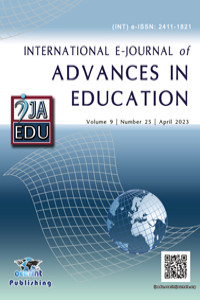Abstract
References
- Basturkmen, H. (2010). Developing courses in English for Specific Purposes. University of Auckland, New Zealand. Dudley-Evans T.& John M. (1998). Developments in English for Specific Purposes A multi-disciplinary approach. Cambridge University Press.
- Hutchinson T. & Waters A. (1994). English for Specific Purposes. Glasgow. Cambridge University Press. Hyland K. (2006). English for Academic Purposes. Routledge; 1 edition.
- Laurence A. (1998). Defining English for Specific Purposes and the Role of the ESP Practitioner. Okayama University of Science file:///C:/Users/User/Downloads/Defining_English_for_Specific_Purposes_and_the_Rol.pdf Nelson D. & Devardhi J. & Tadesse A. (2012). The issues involved in ESP course design. Language in India, Volume 12:9,126-139.
- Robinson P. (1991) ESP today. London: Prentice Hall.
- Shahid Abrar-ul-Hassan. (2012) Revisiting the ins and outs of ESP practice. Journal of the IATEFL ESP SIG April issue 39,4-11.
- Ulusan, A. R. (2017). English for Specific Purposes: A supplementary to Richards and Rodgers` Approaches and methods in language teaching (Third edition). Baskent University Journal of Education,4 (1), 50-60.
Abstract
From 2016 many educational projects organized for Higher Educational Institutions of Uzbekistan and one of them is EnSPIRE-U (English for Specific Purposes Integrated Reform in Uzbekistan) organized by British Council. Moving from centralized, course book-based system to sudden freedom has brought its fair share of challenges. The purpose of this article is to look new trends in teaching ESP in Uzbekistan with the project EnSPIRE-U and piloting new syllabus for the 1st year students of pharmaceutical directions in three institutions of Uzbekistan: Tashkent pharmaceutical Institute, Nukus Medical Institute (pharmaceutical direction) and Andijan Medical Institute (pharmaceutical direction). Research had started in 2016 with base-line study identifying learning needs of pharmaceutical students in Uzbekistan. Further, from 2018 designing and piloting materials in ESP lessons. Results of this study show that using authentic materials developed professional communicative competence in English of future pharmacists.
Keywords
English for Specific Purposes English for General Purposes experimental groups controlling groups needs analysis
References
- Basturkmen, H. (2010). Developing courses in English for Specific Purposes. University of Auckland, New Zealand. Dudley-Evans T.& John M. (1998). Developments in English for Specific Purposes A multi-disciplinary approach. Cambridge University Press.
- Hutchinson T. & Waters A. (1994). English for Specific Purposes. Glasgow. Cambridge University Press. Hyland K. (2006). English for Academic Purposes. Routledge; 1 edition.
- Laurence A. (1998). Defining English for Specific Purposes and the Role of the ESP Practitioner. Okayama University of Science file:///C:/Users/User/Downloads/Defining_English_for_Specific_Purposes_and_the_Rol.pdf Nelson D. & Devardhi J. & Tadesse A. (2012). The issues involved in ESP course design. Language in India, Volume 12:9,126-139.
- Robinson P. (1991) ESP today. London: Prentice Hall.
- Shahid Abrar-ul-Hassan. (2012) Revisiting the ins and outs of ESP practice. Journal of the IATEFL ESP SIG April issue 39,4-11.
- Ulusan, A. R. (2017). English for Specific Purposes: A supplementary to Richards and Rodgers` Approaches and methods in language teaching (Third edition). Baskent University Journal of Education,4 (1), 50-60.
Details
| Primary Language | English |
|---|---|
| Subjects | Other Fields of Education |
| Journal Section | Articles |
| Authors | |
| Publication Date | May 4, 2023 |
| Submission Date | March 2, 2023 |
| Published in Issue | Year 2023Volume: 9 Issue: 25 - April 2023 |
Published and Sponsored by OCERINT International © 2015 - 2025
Contact: ijaedujournal@hotmail.com
International E-Journal of Advances in Education by IJAEDU is licensed under a Creative Commons Attribution-NonCommercial 4.0 International License. Permissions beyond the scope of this license may be available at http://ijaedu.ocerintjournals.org



